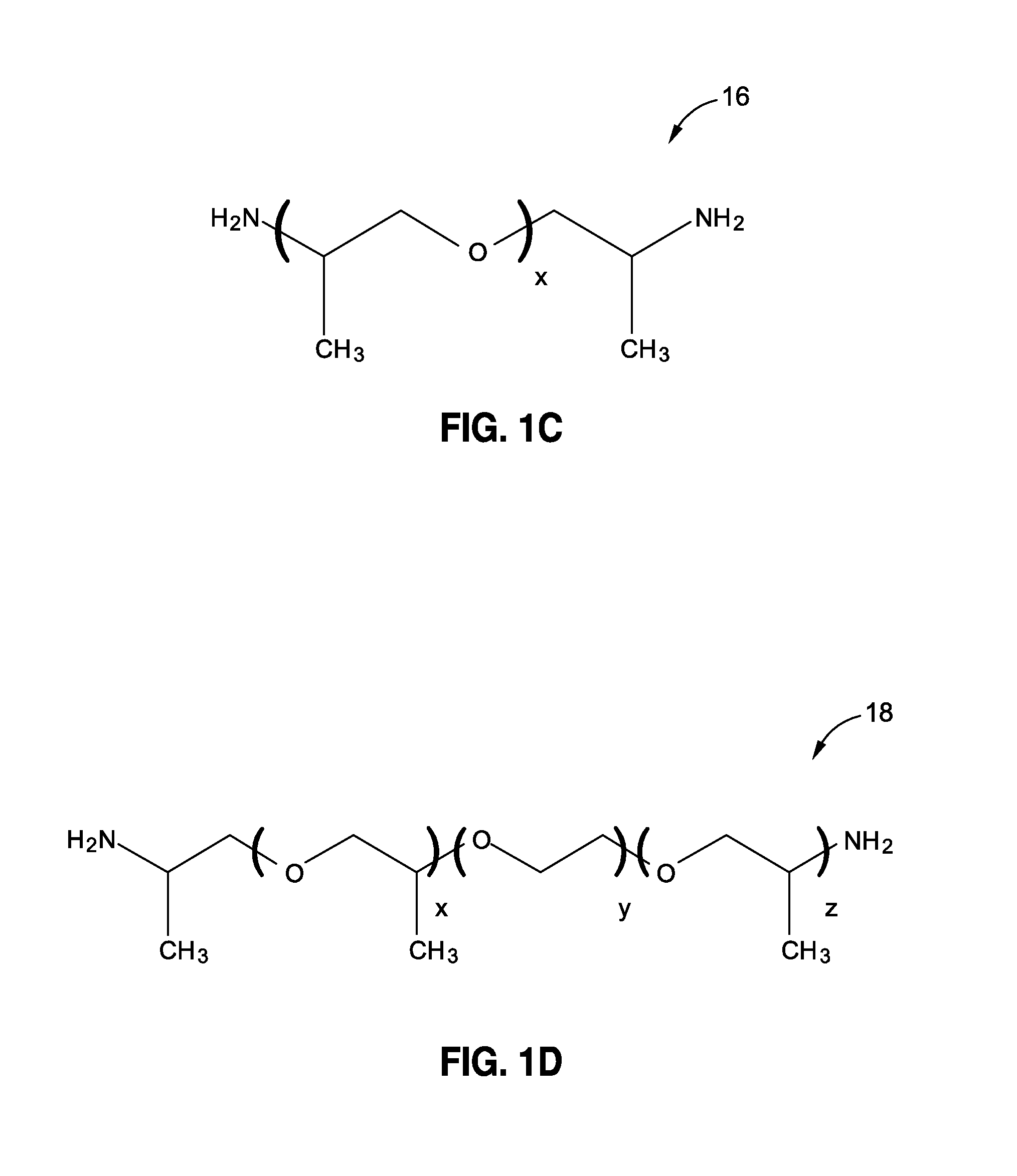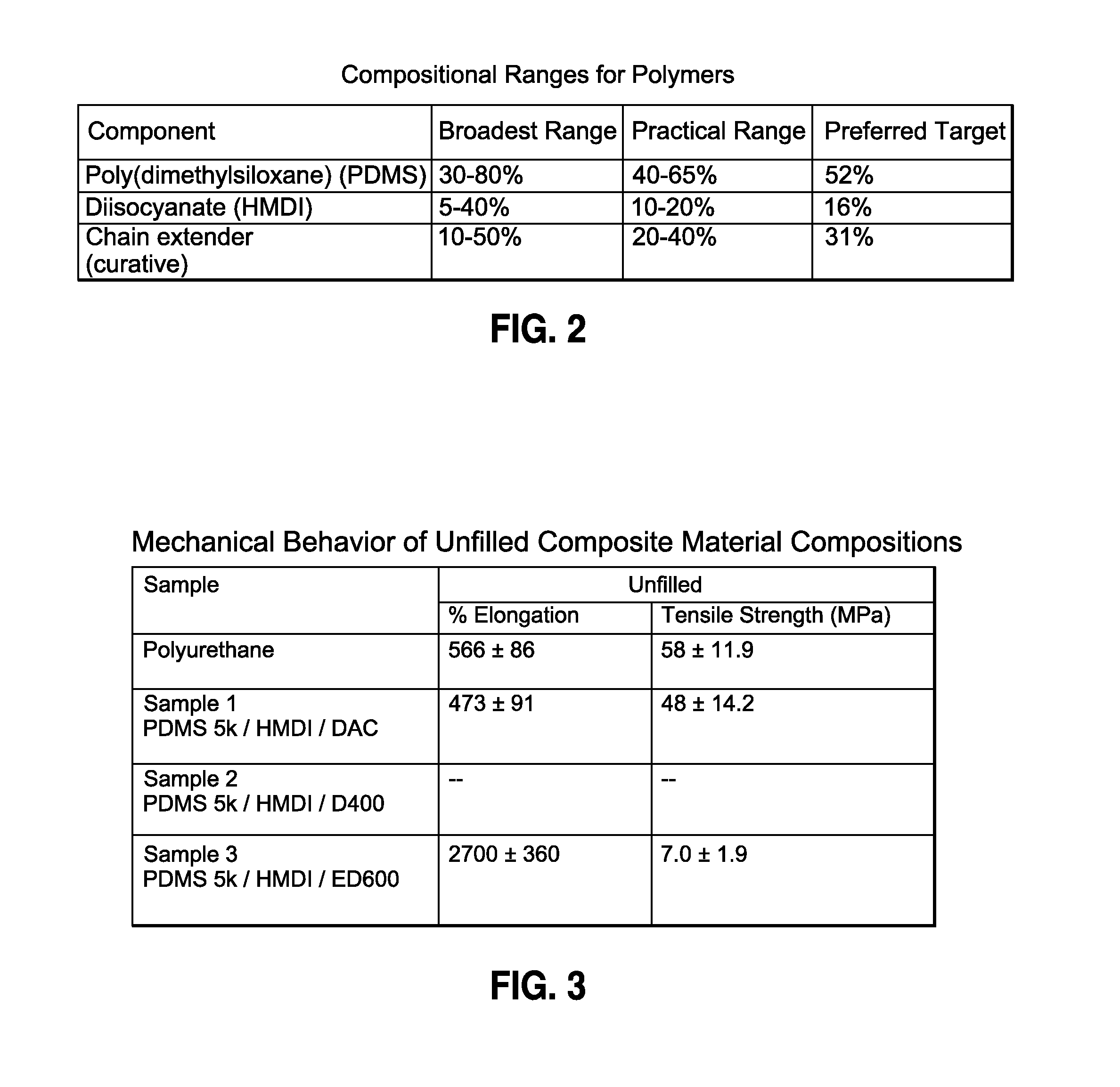Flexible, Low Temperature, Filled Composite Material Compositions, Coatings, and Methods
a composite material, low temperature technology, applied in the direction of coatings, polyurea/polyurethane coatings, etc., can solve the problems of reducing mechanical strength at low temperature, elastomers may not maintain their advantageous elastic properties, and elastomers to stiffen and become brittle, etc., to achieve high flexibility, high flexibility, and high flexibility
- Summary
- Abstract
- Description
- Claims
- Application Information
AI Technical Summary
Benefits of technology
Problems solved by technology
Method used
Image
Examples
example 1
[0058]Unfilled Aerospace Polyurethane Resin (“Unfilled Polyurethane”).
[0059]In Example 1, an unfilled Polyurethane sample was charged to a vial and combined with a curative. Methyl ethyl ketone (MEK) was added as necessary to dilute the viscous resin to that of a pourable viscosity and the transferred into a 3 inch by 3 inch PTFE (polytetrafluoroethylene) mold and covered overnight. The MEK was then removed through evaporation to produce a film (approximately 0.5 mm (millimeters) thick) for use in mechanical testing.
[0060]Tensile testing was performed with the unfilled Polyurethane sample and a percent (%) elongation obtained was 566+ / −86% (see FIG. 3), and a tensile strength obtained was 58+ / −11.9 MPa (megapascals) (see FIG. 3). Dynamic mechanical analysis was performed with the unfilled Polyurethane sample with results shown in FIG. 5.
example 2
[0061]Unfilled PDMS 5k / HMDI / DAC Sample 1.
[0062]In Example 2, unfilled PDMS 5k / HMDI / DAC Sample 1 was prepared. PDMS-α,ω-dihydroxy terminated poly(dimethylsiloxane) (5.0 g, 0.893 mmoles) and HMDI (1.17 g, 4.46 mmoles) were charged to a vial and stirred with heating at 100° C. for eight (8) hours with triethylamine as catalyst (40 mg) in a Nitrogen glove box. The mixture was then cooled to ambient temperature. Isopropanol (8 g) dried over 4 Angstrom molecular sieves was added to the mixture and stirred until the mixture was homogeneous. In a separate vial, DAC was measured (407 mg, 3.57 mmoles) and dissolved in isopropanol (2 g) that had been dried over 4 Angstrom molecular sieves. These two solutions were combined and vigorously mixed. After approximately five (5) minutes, the solution was poured into a three inch by three inch (3″×3″) PTFE (polytetrafluoroethylene) mold and covered overnight. The isopropanol was then removed through evaporation to produce a film (approximately 0.5 mm...
example 3
[0064]Unfilled PDMS 5k / HMDI / ED600 Sample 3.
[0065]In Example 3, unfilled PDMS 5k / HMDI / ED600 Sample 3 was prepared. For the initial prepolymer resin synthesis for Sample 3, α,ω-(alpha, omega)-dihydroxy terminated poly(dimethylsiloxane) (PDMS) (500 g, 100 mmoles) was charged to a three necked 1000 mL (milliliter) flask. HMDI (157.2 g, 600 mmoles) was then added and an overhead TEFLON (TEFLON is a registered trademark of E.I. Du Pont De Nemours and Company of Wilmington, Del.) paddle stirrer was fitted through an adapter in the center neck. The atmosphere of the headspace in the flask was continuously purged with nitrogen during the course of the reaction. An oil bath was placed under the flask and set to 110° C. (degrees Celsius) while the paddle stirrer was adjusted to 300 rpm (revolutions per minute). Upon reaching a reaction temperature of 110° C., triethylamine (0.5 mL) was introduced into the reaction and allowed to mix for three hours (3 hrs). Another aliquot of triethylamine (0....
PUM
| Property | Measurement | Unit |
|---|---|---|
| Temperature | aaaaa | aaaaa |
| Fraction | aaaaa | aaaaa |
| Percent by mass | aaaaa | aaaaa |
Abstract
Description
Claims
Application Information
 Login to View More
Login to View More - R&D
- Intellectual Property
- Life Sciences
- Materials
- Tech Scout
- Unparalleled Data Quality
- Higher Quality Content
- 60% Fewer Hallucinations
Browse by: Latest US Patents, China's latest patents, Technical Efficacy Thesaurus, Application Domain, Technology Topic, Popular Technical Reports.
© 2025 PatSnap. All rights reserved.Legal|Privacy policy|Modern Slavery Act Transparency Statement|Sitemap|About US| Contact US: help@patsnap.com



